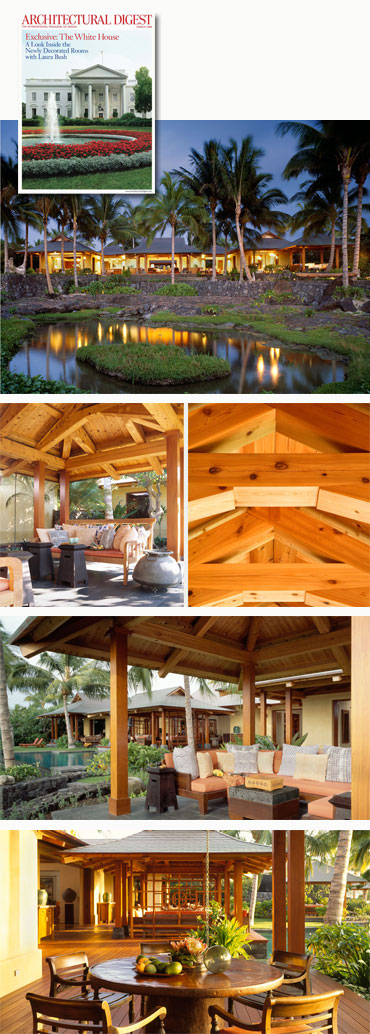
Bali has long been the kind of place people visit and think, “I could live here.” That’s how it was for Paul and Cassandra Hazen, who first traveled there on their honeymoon, returning year after year to savor its unique beauty and explore the artists’ communities in the mountains.
Although moving to Bali was out of the question, the Hazens were contemplating building a house in a place with its own natural charms but much closer to home—on Hawaii, where they owned a condominium. “The architecture in Bali is very special—with open rooms on a platform where the family would spend time together,” says Cassandra Hazen. “That’s how we wanted our house.” The property they acquired on a secluded stretch of the Kona Coast offered intriguing possibilities: Set away from the ocean and encompassing about an acre, it features two brackish-water ponds that are protected from development. Indeed, adds Cassandra Hazen, “we picked this particular area because of the ponds. They were a fishing source for ancient Hawaiians.”
They contacted Bay Area architect Shay Zak, whose work they admired, and began creating a pavilion-style residence evocative of those found on Bali. Before they broke ground, the couple took Zak to Indonesia so that he could see firsthand what they were talking about.
He envisioned a series of pavilions arranged around a lushly planted courtyard—a nod to the traditional Balinese garden, which is like an outdoor room. (Hawaii-based Scott Seymour oversaw the landscape design.) Containing the living room, dining room, kitchen and master bedroom, the main pavilion is set on the ocean side of the property. Floors of ipe wood lead from inside to outside, onto lanais off the living room, dining room and master bedroom. In addition to ipe, Zak used teak and, for the open-trussed ceilings, western-ridge cedar. “The hallmark of our projects is the use of natural materials; nothing’s ever painted,” he says. Guest quarters and a game/entertainment room are in separate, smaller pavilions. “When you’re walking around the property, you get these amazing views between the buildings,”says Zak.
Together the pavilions comprise more than 10,000 square feet, and though the ceilings rise to some 20 feet, the feel throughout is comfortable and intimate. “We wanted the house to be functional and casual but at the same time aesthetically pleasing,” Cassandra Hazen explains.
Initially she set out to design the interiors herself, furnishing them with pieces she and her husband had found on their travels, including a stone Buddha from the town of Ubud (it now sits serenely beneath a canopy of plumeria and palm trees in the garden). In the end, she called on San Francisco-based designer Douglas Durkin, whom she’d met previously.
“She’d done her homework on what she wanted for the house,” he recalls. “She wanted it to feel eclectic and personal, which was a very good fit for us.”
Durkin and his design director, Greg Elich, work frequently in Hawaii, and they travel regularly to Indonesia to have furnishings made by local craftspeople.
The house’s generous proportions posed no dilemma for the designers. “People get a little afraid of those kinds of gestures, but to Cassandra’s credit, when she was shopping, she knew she was going to want big things,” says Durkin. Among them was a slab of antique ironwood that now serves as a tabletop in the living room. He balanced it with a Chinese elmwood cabinet and low tables he and Elich had made of reclaimed teak. Says Elich, “Not only is it beautiful wood, there’s a spirituality around something with a history.”
They also designed beds based on Balinese pavilion posts and beams. “In the master bedroom, we floated the bed in the middle of the room,” Durkin says. “The ceiling elements there are quite robust, so anything less robust underneath just wouldn’t feel up to the architecture.”
All the spaces are connected through materials and palette. Recalls Durkin, “Cassandra had found a very beautiful, very old Kalimantan mat done in black and golden-color straw, and she asked, ‘Can we use this?’ And I said, ‘Why don’t we take the designs and blow them up onto the carpets?’ The rooms have a very subtle geometric design running through them. They’re done in silk and wool, so they’re very comfortable on the feet.”
And rather than purchase batiks in Indonesia, the designers opted for cotton fabrics custom-printed in India. “We used them from room to room, superimposing these light batik-style fabrics on more intensely colored upholstery fabrics,” Durkin notes.
Cassandra Hazen and her husband have plenty of reasons to return to their Hawaiian home: Three years ago she bought 30 acres of coffee plants and started the Brazen Hazen coffee company.
“As soon as I come into the house, the combination of hearing the ocean and the breeze through the trees puts me instantly into a Zen mode,” she says. “Being here is like meditation—it’s very peaceful.”
Project Featured: Courtyard House
Interior Design: Douglas Durkin & Greg Elich of Douglas Durkin Design
Photography: Matthew Millman
